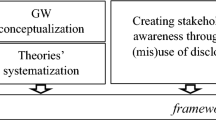Abstract
We test a model of states' adoption of the hazardous waste liability regime (negligence, strict liability) providing greater net benefits. The likelihood of adopting strict liability increases in a state's number of chemical-intensive manufacturing plants, decreases in the number of large mining establishments. Also predictive: severity of state's hazardous waste problem, effectiveness of other state environmental programs, and political climate. States may view strict liability as better for industrial than mining pollution, and may be partly motivated by "precaution targeting" and "deep pockets" mentality. Non-adopters may wish not to discourage business or have other programs that substitute for strict liability.
Similar content being viewed by others
References
Barnett, Harold. 1994. Toxic Debts and the Superfund Dilemma. Chapel Hill: The University of North Carolina Press.
Chamberlain, Gary. 1980. “Analysis of Covariance with Qualitative Data,” Review of Economic Studies 47:225-238.
Cropper, Maureen, William N. Evans, Stephen J. Berardi, Maria M. Ducla-Soares, and Paul R Portney. 1992. “The Determinants of Pesticide Regulation: A Statistical Analysis of EPA Decision Making.” Journal of Political Economy 100(1):175-198.
Environmental Law Institute. 1993. “An Analysis of State Superfund Programs: 50-State Study. 1993 Update.” Prepared for the US Environmental Protection Agency, Washington, DC, December.
Environmental Law Institute. 1995. “An Analysis of State Superfund Programs: 50-State Study. 1995 Update.” Prepared for the US Environmental Protection Agency, Washington, DC, December.
Fogleman, Valerie M. 1992. Hazardous Waste Cleanup, Liability, and Litigation. Westport, Conn.: Quorum Books.
Gupta, Shreekant, George Van Houtven, and Maureen Cropper. 1996. “Paying for Permanence: An Economic Analysis of EPA's Cleanup Decisions at Superfund Sites.” RAND Journal of Economics 27:563-582.
Hall, Bob, and Mary Lee Kerr. 1992. The 1991–92 Green Index. Covelo, CA: Island Press.
Hanley, Nick, Jason F. Shogren, and Ben White. 1997. Environmental Economics In Theory and Practice. Oxford, U.K.: Oxford University Press.
Harper, Richard K., and Stephen C. Adams. 1996. “CERCLA and Deep Pockets: Market Response to the Superfund Program.” Contemporary Economic Policy 14:107-113.
Holmes, Thomas (forthcoming), “The Effect of State Policies on the Location of Manufacturing: Evidence from State Borders.” Journal of Political Economy.
King, Susan M. 1988. “Lenders Liability for Environmental Law.” Environmental Law 18:241-291.
Maddala, G. S. 1983. Limited-Dependent and Qualitative Variables in Econometrics. New York: Cambridge University Press.
Magat, Wesley A., Alan J. Krupnick, and Winston Harrington. 1986. Rules in the Making. A Statistical Analysis of Regulatory Agency Behavior. Washington, DC: Resources for the Future.
Probst, Katherine N., Don Fullerton, Robert E. Litan, and Paul R. Portney. 1995. Footing the Bill for Superfund Cleanups: Who Pays and How? Washington, DC: Resources for the Future.
Ringleb, Al H., and Steven N. Wiggins. 1990. “Liability and Large-Scale, Long-Term Hazards.” Journal of Political Economy 98(3):574-595.
Rinquist, Evan J. 1993. Environmental Protection at the State Level. Politics and Progress in Controlling Pollution. Armonk, New York: M.E. Sharpe.
Tietenberg, Tom H. 1989. “Indivisible Toxic Torts: The Economics and Joint and Several Liability.” Land Economics 65(4): 305-319.
Tolley, George, Donald Kenkel, and Robert Fabian, eds. 1994. Valuing Health for Policy: An Economic Approach. Chicago: The University of Chicago Press.
U.S. Environmental Protection Agency, Office of Emergency and Remedial Response. 1989. “An Analysis of State Superfund Programs: 50-State Study.” Washington, D.C.
U.S. Environmental Protection Agency, Office of Emergency and Remedial Response. 1990. “An Analysis of State Superfund Programs: 50-State Study. 1990 Update.” Washington, D.C.
U.S. Environmental Protection Agency, Office of Emergency and Remedial Response. 1991. “An Analysis of State Superfund Programs: 50-State Study. 1991 Update.” Washington, D.C.
U.S. Environmental Protection Agency, Office of Pollution Prevention and Toxics. 1995. 1987–1993 Toxics Release Inventory CD-ROM. Washington, D.C.
Viscusi, W. Kip. 1993. Fatal tradeoffs, Public & Private Responsibilities for Risk. New York: Oxford University Press.
Author information
Authors and Affiliations
Rights and permissions
About this article
Cite this article
Alberini, A., Austin, D. On and Off the Liability Bandwagon: Explaining State Adoptions of Strict Liability in Hazardous Waste Programs. Journal of Regulatory Economics 15, 41–64 (1999). https://doi.org/10.1023/A:1008096808038
Issue Date:
DOI: https://doi.org/10.1023/A:1008096808038




